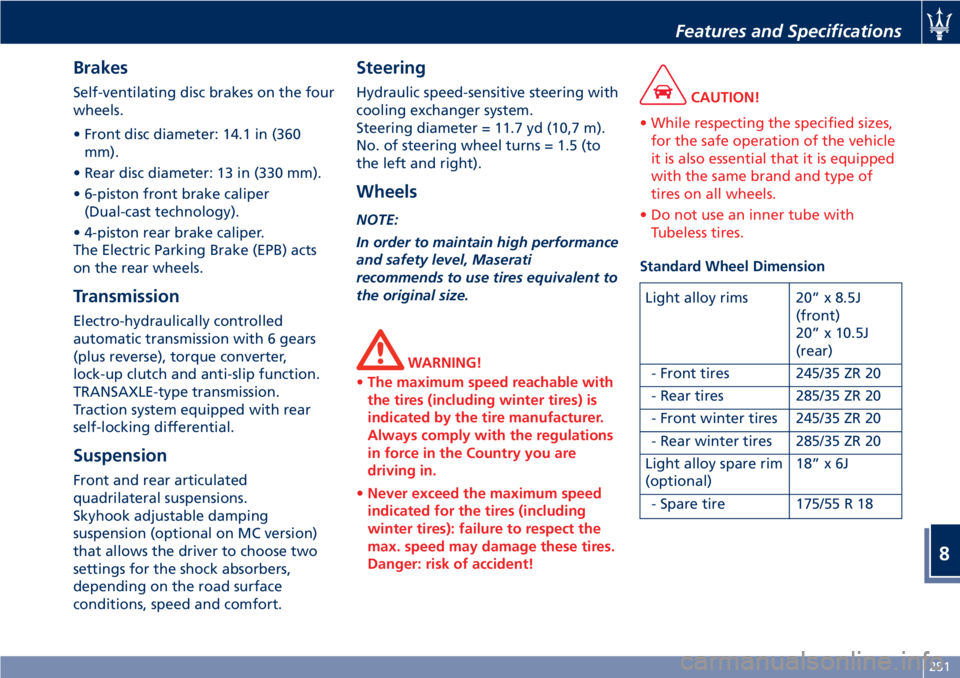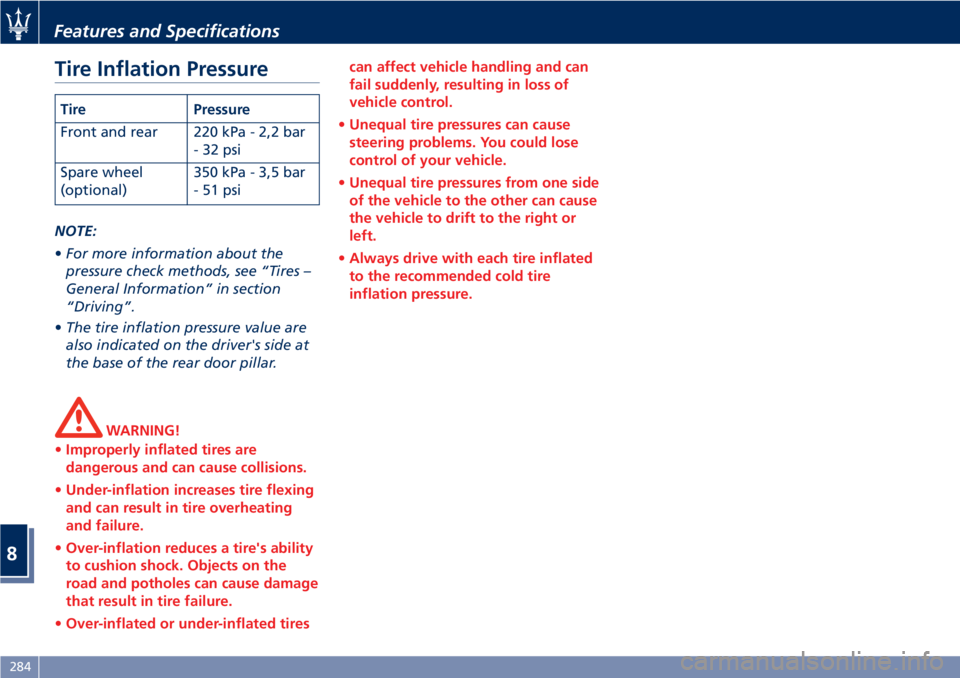Page 223 of 296

approximately 44 lb (20 kg) being
placed on the handle of the wrench
supplied when extended for use.
•After refitting the standard wheel,
check the tire pressure.
WARNING!
•The spare wheel is narrower than
standard wheels and must only be
used to travel the distance required
to reach a service station, where the
punctured tire can be repaired or
replaced.
•Do not exceed a maximum speed of
50 mph (80 km/h) when using the
compact spare wheel; when this
limit is exceeded, the stability, road
holding and braking of the vehicle
will be compromised. Avoid
accelerating to full speed, heavy
braking and fast cornering.
•The compact spare wheel must be
inflated to the recommended tire
pressure (see “Tire Inflation
Pressure” in section “Features and
Specifications”).
•For safety reasons, it is absolutely
forbidden to drive with more than
one compact spare wheel fitted on
the vehicle.•Snow chains cannot be fitted on the
compact spare wheel.
•The spare wheel can travel a
maximum of 1,800 mi (3.000 km).
NOTE:
The used wheel may soil the mats if it
is housed in the car: insert the used
wheel in the protective bag housed in
the side pocket of the covering bag.
To Refit the Standard Wheel with
Repaired or Replaced Tire
• Following the procedure and the
caution described above, raise the
vehicle and remove the compact
spare wheel reusing the supplied
wrench with adapter, suitably
extended.
• Fit the standard wheel with repaired
or replaced tire.
• Tighten the original bolts on the
wheel.
• Lower the vehicle and remove the
jack.
• Fully tighten the bolts, alternately
tightening diametrically opposite.
WARNING!
•Observe the tightening torque for
the bolts securing the wheels (72 ±
7 lbf·ft / 98 ± 10 Nm). This is
equivalent to a load of
approximately 44 lb (20 kg) being
placed on the handle of the wrench
supplied when extended for use.
•After refitting the standard wheel,
check the tire pressure.
Once finished:
• completely deflate the compact
spare wheel by pressing on the valve
with the overhang of the valve cap;
• wrap the power cable and the
inflation hose inside the compressor
case;
• place the compressor, the jack, the
wrench and the adapter in the
In an Emergency
6
219
Page 285 of 296

Brakes
Self-ventilating disc brakes on the four
wheels.
• Front disc diameter: 14.1 in (360
mm).
• Rear disc diameter: 13 in (330 mm).
• 6-piston front brake caliper
(Dual-cast technology).
• 4-piston rear brake caliper.
The Electric Parking Brake (EPB) acts
on the rear wheels.
Transmission
Electro-hydraulically controlled
automatic transmission with 6 gears
(plus reverse), torque converter,
lock-up clutch and anti-slip function.
TRANSAXLE-type transmission.
Traction system equipped with rear
self-locking differential.
Suspension
Front and rear articulated
quadrilateral suspensions.
Skyhook adjustable damping
suspension (optional on MC version)
that allows the driver to choose two
settings for the shock absorbers,
depending on the road surface
conditions, speed and comfort.
Steering
Hydraulic speed-sensitive steering with
cooling exchanger system.
Steering diameter = 11.7 yd (10,7 m).
No. of steering wheel turns = 1.5 (to
the left and right).
Wheels
NOTE:
In order to maintain high performance
and safety level, Maserati
recommends to use tires equivalent to
the original size.
WARNING!
•The maximum speed reachable with
the tires (including winter tires) is
indicated by the tire manufacturer.
Always comply with the regulations
in force in the Country you are
driving in.
•Never exceed the maximum speed
indicated for the tires (including
winter tires): failure to respect the
max. speed may damage these tires.
Danger: risk of accident!
CAUTION!
• While respecting the specified sizes,
for the safe operation of the vehicle
it is also essential that it is equipped
with the same brand and type of
tires on all wheels.
• Do not use an inner tube with
Tubeless tires.
Standard Wheel Dimension
Light alloy rims 20” x 8.5J
(front)
20” x 10.5J
(rear)
- Front tires 245/35 ZR 20
- Rear tires 285/35 ZR 20
- Front winter tires 245/35 ZR 20
- Rear winter tires 285/35 ZR 20
Light alloy spare rim
(optional)18”x6J
- Spare tire 175/55 R 18
Features and Specifications
8
281
Page 288 of 296

Tire Inflation Pressure
Tire Pressure
Front and rear 220 kPa - 2,2 bar
-32psi
Spare wheel
(optional)350 kPa - 3,5 bar
-51psi
NOTE:
•For more information about the
pressure check methods, see “Tires –
General Information” in section
“Driving”.
•The tire inflation pressure value are
also indicated on the driver's side at
the base of the rear door pillar.
WARNING!
•Improperly inflated tires are
dangerous and can cause collisions.
•Under-inflation increases tire flexing
and can result in tire overheating
and failure.
•Over-inflation reduces a tire's ability
to cushion shock. Objects on the
road and potholes can cause damage
that result in tire failure.
•Over-inflated or under-inflated tirescan affect vehicle handling and can
fail suddenly, resulting in loss of
vehicle control.
•Unequal tire pressures can cause
steering problems. You could lose
control of your vehicle.
•Unequal tire pressures from one side
of the vehicle to the other can cause
the vehicle to drift to the right or
left.
•Always drive with each tire inflated
to the recommended cold tire
inflation pressure.
Features and Specifications
8
284